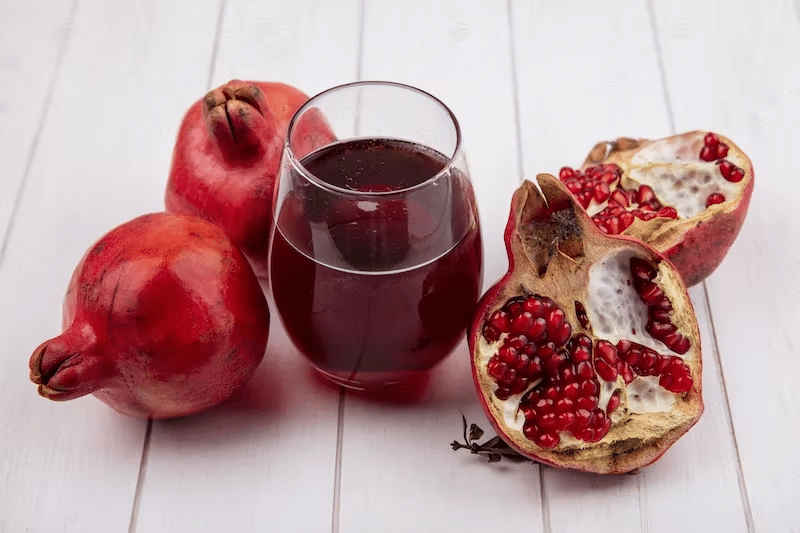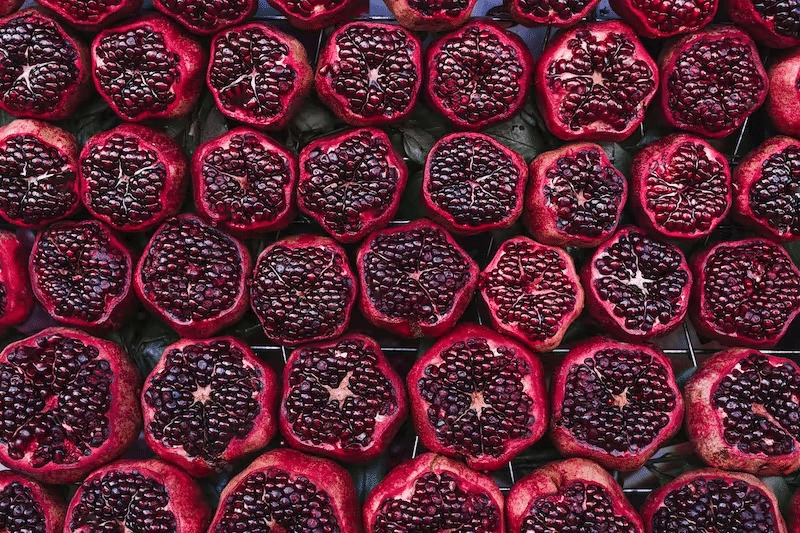
The pomegranate is a fruit with an unusual shape and colour. It has a very strong smell and is used in many dishes. This fruit juice can be seen in various drinks, such as orange juice, pomegranate juice, etc. This article will explain the steps to make pomegranate juice at home and its benefits for human consumption.

Pomegranate juice is a fruit that is a member of the citrus family. It has a distinctive red colour and is rich in vitamin C. It is also used in different cooking and nutritional products and can be found in many countries around the world.
Pomegranate juice is naturally thick with a sweet taste. The juice is often used in food items such as cereals, salads, and desserts. It has been used in many countries during the winter season to protect against cold and improve immunity.

Pomegranates are hard-shelled fruits that contain a large number of tiny crimson teardrop-shaped gem seeds. Only the pomegranate arils, which are the seeds, can be consumed or juiced. Although an electric juicer can be used, manual juicing is typically advised when attempting to obtain juice from pomegranate seeds.
When using a manual juicer, the process can be done similarly to juicing an orange or lemon. When using an electric juicer, the arils must be thoroughly separated from the white membrane before juicing.
Pomegranate fresh juice is a fruit that has been around for centuries. It was used as medicine for centuries because it has a lot of health benefits, such as:
But it also has some negative properties, like causing skin problems and making it red if consumed in large quantities. To ensure that the pomegranate juice does not negatively affect your health or appearance, you should consume it in small quantities only once in a while and at least thrice a week.
The best time of day to drink pomegranate juice is in the morning. Pomegranate juice is a great source of antioxidants and vitamins, which can help boost your immune system and provide energy for the day ahead.
Drinking pomegranate juice in the morning can also help you stay hydrated throughout the day, as it contains high levels of electrolytes.
Pomegranate juice is a delicious and nutritious drink that can be enjoyed on its own or used as an ingredient in other recipes. Making your pomegranate juice at home is easy and requires only a few simple ingredients.
Here’s the list of pomegranate juice recipes that you’ll need to make fresh juice:
Enjoying Your Pomegranate Juice
Making pomegranate juice is a simple and delicious way to enjoy the health benefits of this antioxidant-rich fruit.
Here are the steps for making your own pomegranate juice at home:
Making pomegranate juice without a juicer is easy and requires only a few simple steps.
Fresh Pomegranate juice is a delicious and nutritious beverage that many people can enjoy. However, some individuals should not drink pomegranate juice due to potential health risks.
Pomegranate overconsumption can result in several illnesses, including nausea, vomiting, abdominal pain, and diarrhoea in some people. Anecdotal data suggests that consuming this fruit in excess may also irritate the digestive system.
Pomegranate juice is a fruit that comes in many colours. It is made from the pulp of pomegranate, considered one of the most nutritious fruits. It also tastes amazingly good! Start making your own and start living a healthy lifestyle.
Was this article helpful? Let us know in the comments.
The most common pomegranates are the common ones like the “pomegranate” and the “kiwi”. They are roundish, with a sweet and juicy taste. The fruit is grown in warm climates, such as those in Europe or North America.
It’s completely safe to consume pomegranate juice on an empty stomach. It is a water-based fruit that also contains electrolytes. Hence pomegranate juice can hydrate your body first thing in the morning. Many of its nutrients get absorbed on an empty stomach.
Pomegranates contain 40% of your recommended daily intake of vitamin C. The ideal method to consume it is with freshly squeezed juice because a lot of it is lost during production.
Pearl Lemon Juice is a part of the Pearl Lemon Group. We also own Bubble Tea, Matcha, and Coffee beverage café’s in Fulham and Marleybone!
© All Rights Reserved | Company Number: 10411490 | VAT Number: 252 7124 23 | Sitemap